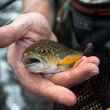In fly fishing, everyone is an originator of a new knot -- at least it seems that way. One look on the internet will convince anyone. There are more than enough to fill an entire book, like Left Kreh and Mark Sosin's Practical Fishing Knots. And while it's fun, and even useful at times to know dozens of knots, there are a core of knots that will serve the fly fisher well, regardless of line weight, fly size or species being sought. In addition, there are some essential knot tying strategies that every angler must know.
Form the knots carefully and correctly
Practice with a rope kit. Use two hanks of soft, braided nylon rope, one 1/8 inch (3mm) in diameter, and one 3/16 inch (4.5mm) in diameter, each about 3 feet long, to practice tying the knots. It's a great way to learn the nuances of the hand movements needed to correctly tie the knots, and it's a lot easier to see and handle the ropes than gossamer strands of nylon.
Always lubricate the knot
When tying in monofilament, always lubricate the knot (saliva usually works fine) before pulling it tight. If the mono is not lubed, it can burn/cut as the material comes tight, weakening the finished knot. There are also commercial knot lubricants that work very well to keep the mono from burning as the knot is drawn tight.
Pull the knots smoothly tight
No jerking, no super swift pulling. Smoothly and evenly pull the knot tight. Someone once said that fishing was a jerk on one end of a line waiting for a jerk on the other. But regardless of one's personality problems and fishing style, don't jerk the knots. Jerking the knots damages the mono.
Ever get a mono cut as you pulled hard on a piece and it suddenly slipped over a finger? If not, you don't want to. If so, you know how painful a mono cut can be and how little blood is lost even when they go very deep. Why? The mono burns its way in, fiercely stimulating the nerve endings and cauterizing the blood vessels as it goes. Jerking or swift pulls cause the mono to burn itself. A smooth and even pull prevents burning.
Once the knot has come tight, stretch
Stretch the monofilament as far as it will go and then hold it for a few seconds; this allows the material in the knot to stretch. The stretched material will be the smallest in diameter that it can be, and will form the tightest knot possible. If the material is not stretched, the knot can slip and jerk tight as the angler fights the fish, suddenly reducing in its strength.
Have you ever tied a knot in a rubber band? If not, go get one and tie a simple overhand knot in it. Pull on the rubber band and stretch it out nice and tight. Watch the knot as you do so. The material in the knot will stretch, and the knot will get smaller and smaller until it's as tight as it can get. When you let go of the rubber band, the knot doesn't get big again, it stays as tight as it will ever be.
The same thing happens in mono. When you stretch it and hold it, the material in the knot stretches and tightens, forming the tightest, .i.e. strongest, possible knot that you can make. Once it's absolutely tight, you can jerk against it all you want without causing any damaging internal movement.
And finally, pull-test any knot
By that I mean, stretch the material not only to tie the knot more tightly, but also to test the security of its hold. While holding the tippet stretched when tying the Clinch Knot, for example, I often work it back and forth a few times just to be certain the knot is secure and won't slip. This simple aspect of tying knots is easy to forget in the heat of fishing, but it can save you from a potentially lost fish.
Editor's note: The above is an excerpt from Fly Gear, Volume 5 and the latest in Gary Borger's Fly Fishing, the Book Series. Imagine a lifetime of fishing knowledge laid out on paper for anglers of the world to pore over and absorb, and that's what you've got in Gary's series, planned to span an amazing 20 volumes. What Gary has already compiled in the first five volumes is of incredible value and more than most anglers will come to know in their angling career (that is, unless they read the books themselves). Packed with stories and anecdotes from a lifetime of fishing the world, 'Fly Fishing, the Book Series' isn't only informative, it's a pleasure to read. More at www.garyborger.com.































Comments
fish on replied on Permalink
Always tie a new knot if you create memory (crinkles) in your line from tightening the knot.
Always tie a new knot if you get a knot in your line from casting which creates a weak spot in your line and will break when you hook a decent size fish.
Never hesitate to tie a new knot!
Chad Shmukler replied on Permalink
A very good addition indeed. I can remember, when I was a beginner, settling for the most atrocious knots (which of course, inevitably failed the first time a fish was hooked, rock was snagged and so on), simply to avoid the hassle of retying them.
Not only is a poorly tied, sloppy knot unlikely to fish well -- retying it is good practice.
Seemingly impossible feats of dexterity often become commonplace very quickly given a little bit of practice.
Pages